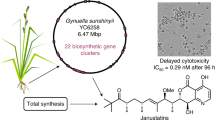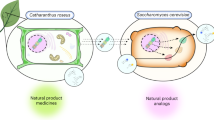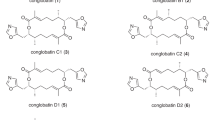Abstract
Leucascandrolide A and neopeltolide are structurally homologous marine natural products that elicit potent antiproliferative profiles in mammalian cells and yeast. The scarcity of naturally available material has been a significant barrier to their biochemical and pharmacological evaluation. We developed practical synthetic access to this class of natural products that enabled the determination of their mechanism of action. We demonstrated effective cellular growth inhibition in yeast, which was substantially enhanced by substituting glucose with galactose or glycerol. These results, along with genetic analysis of determinants of drug sensitivity, suggested that leucascandrolide A and neopeltolide may inhibit mitochondrial ATP synthesis. Evaluation of the activity of the four mitochondrial electron transport chain complexes in yeast and mammalian cells revealed cytochrome bc1 complex as the principal cellular target. This result provided the molecular basis for the potent antiproliferative activity of this class of marine macrolides, thus identifying them as new biochemical tools for investigation of eukaryotic energy metabolism.
This is a preview of subscription content, access via your institution
Access options
Subscribe to this journal
Receive 12 print issues and online access
$259.00 per year
only $21.58 per issue
Buy this article
- Purchase on Springer Link
- Instant access to full article PDF
Prices may be subject to local taxes which are calculated during checkout






Similar content being viewed by others
References
Paterson, I. & Anderson, E.A. The Renaissance of natural products as drug candidates. Science 310, 451–453 (2005).
D'Ambrosio, M., Guerriero, A., Debitus, C. & Pietra, F. Leucascandrolide A, a new type of macrolide: the first powerfully bioactive metabolite of calcareous sponges Leucascandra caveolata, a new genus from the Coral Sea. Helv. Chim. Acta 79, 51–60 (1996).
Wright, A.E. et al. Neopeltolide, A macrolide from a Lithistid sponge of the family Neopeltidae. J. Nat. Prod. 70, 412–416 (2007).
Hornberger, K.R., Hamblett, C.L. & Leighton, J.L. Total synthesis of leucascandrolide A. J. Am. Chem. Soc. 122, 12894–12895 (2000).
Kopecky, D.J. & Rychnovsky, S.D. Mukaiyama aldol-Prins cyclization cascade reaction: formal total synthesis of leucascandrolide A. J. Am. Chem. Soc. 123, 8420–8421 (2001).
Wang, Y., Janjic, J. & Kozmin, S.A. Synthesis of leucascandrolide A via a spontaneous macrolactolization. J. Am. Chem. Soc. 124, 13670–13671 (2002).
Fettes, A. & Carreira, E.M. Total synthesis of leucascandrolide A. Angew. Chem. Int. Edn Engl. 41, 4098–4101 (2002).
Paterson, I. & Tudge, M. Stereocontrolled total synthesis of (+)-leucascandrolide A. Angew. Chem. Int. Edn Engl. 42, 343–347 (2003).
Wipf, P. & Reeves, J.T. A formal total synthesis of leucascandrolide A. Chem. Commun. (Camb) 18, 2066–2067 (2002).
Williams, D.R., Plummer, S.V. & Patnaik, S. Formal synthesis of leucascandrolide A. Angew. Chem. Int. Edn Engl. 42, 3934–3938 (2003).
Crimmins, M.T. & Siliphaivanh, P. Enantioselective total synthesis of (+)-leucascandrolide A macrolactone. Org. Lett. 5, 4641–4644 (2003).
Su, Q. & Panek, J.S. Total synthesis of (+)-leucascandrolide A. Angew. Chem. Int. Edn Engl. 44, 1223–1225 (2005).
Jung, H.H., Seiders, J.R. & Floreancig, P.E. Oxidative cleavage in the construction of complex molecules: synthesis of the leucascandrolide A macrolactone. Angew. Chem. Int. Edn Engl. 46, 8464–8467 (2007).
Ferrié, L., Reymond, S., Capdevielle, P. & Cossy, J. Formal chemoselective synthesis of leucascandrolide A. Org. Lett. 9, 2461–2464 (2007).
Youngsaye, W., Lowe, J.T., Pohlki, F., Ralifo, P. & Panek, J.S. Total synthesis and stereochemical reassignment of (+)-neopeltolide. Angew. Chem. Int. Edn Engl. 46, 9211–9214 (2007).
Custar, D.W., Zabawa, T.P. & Scheidt, K.A. Total synthesis and structural revision of the marine macrolide neopeltolide. J. Am. Chem. Soc. 130, 804–805 (2008).
Wang, Y., Janjic, J. & Kozmin, S.A. Synthesis of leucascandrolide A. Pure Appl. Chem. 77, 1161–1169 (2005).
Kozmin, S.A. Efficient stereochemical relay en route to leucascandrolide A. Org. Lett. 3, 755–758 (2001).
Janjic, J. Leucascandrolide A: Synthesis and Studies toward Identification of the Biological Target. Thesis, University of Chicago (2006).
Paterson, I., Gibson, K.R. & Oballa, R.M. Remote, 1,5-Anti stereoinduction in the boron-mediated aldol reactions of β-oxygenated methyl ketones. Tetrahedr. Lett. 37, 8585–8588 (1996).
Evans, D.A., Coleman, P.J. & Côté, B. 1,5-Asymmetric induction in methyl ketone aldol addition reactions. J. Org. Chem. 62, 788–789 (1997).
Chen, K.-M., Hardtmann, G.E., Prasad, K., Repic, O. & Shapiro, M.J. 1,3-syn-diastereoselective reduction of β-hydroxyketones utilizing alkoxydialkylboranes. Tetrahedr. Lett. 28, 155–158 (1987).
Giaever, G. et al. Chemogenomic profiling: identifying the functional interactions of small molecules in yeast. Proc. Natl. Acad. Sci. USA 101, 793–798 (2004).
Baetz, K. et al. Yeast genome-wide drug-induced haploinsufficiency screen to determine drug mode of action. Proc. Natl. Acad. Sci. USA 101, 4525–4530 (2004).
Celenza, J.L., Eng, F.J. & Carlson, M. Molecular analysis of the SNF4 gene of Saccharomyces cerevisiae: evidence for physical association of the SNF4 protein with the SNF1 protein kinase. Mol. Cell. Biol. 9, 5045–5054 (1989).
Hardie, D.G., Carling, D. & Carlson, M. The AMP-activated/SNF1 protein kinase subfamily: metabolic sensors of the eukaryotic cell? Annu. Rev. Biochem. 67, 821–855 (1998).
Nagata, I., Furuya, E., Yoshida, Y., Kanaseki, T. & Tagawa, K. Development of mitochondrial membranes in anaerobically grown yeast cells. J. Biochem. 78, 1353–1364 (1975).
Brown, J. Effect of 2-deoxyglucose on carbohydrate metabolism: review of the literature and studies in rats. Metabolism 11, 1098–1112 (1962).
Linnett, P.E. & Beechey, R.B. Inhibitors of the ATP synthase system. Methods Enzymol. 55, 472–518 (1979).
Haytler, P.G. & Prichard, W.W. A new class of uncoupling agents – carbonyl cyanide phenylhydrazones. Biochem. Biophys. Res. Commun. 7, 272–275 (1962).
Wallace, K.B. & Starkov, A.A. Mitochondrial targets of drug toxicity. Annu. Rev. Pharmacol. Toxicol. 40, 353–388 (2000).
Xia, D. et al. Crystal structure of the cytochrome bc1 complex from bovine heart mitochondria. Science 277, 60–66 (1997).
Iwata, S. et al. Complete structure of the 11-subunit bovine mitochondrial cytochrome bc1 complex. Science 281, 64–71 (1998).
Zhang, Z. et al. Electron transfer by domain movement in cytochrome bc1 . Nature 392, 677–684 (1998).
Trumpower, B.L. Cytochrome bc1 complexes of microorganisms. Microbiol. Rev. 54, 101–129 (1990).
Mitchell, P. Protonmotive redox mechanism of the cytochrome bc-1 complex of the respiratory chain: protonmotive ubiquinone cycle. FEBS Lett. 56, 1–6 (1975).
Trumpower, B.L. The protonmotive Q cycle. J. Biol. Chem. 265, 11409–11412 (1990).
Von Jagow, G., Ljungdahl, P.O., Graf, P., Ohnishi, T. & Trumpower, B.L. An inhibitor of mitochondrial respiration which binds to cytochrome b and displaces quinone from the iron-sulfur protein of the cytochrome bc1 complex. J. Biol. Chem. 259, 6318–6326 (1984).
Thierbach, G. & Reichenbach, H. Myxothiazol, a new inhibitor of the cytochrome bc1 segment of the respiratory chain. Biochim. Biophys. Acta 638, 282–289 (1981).
Thierbach, G., Kunze, B., Reichenbach, H. & Höfle, G. The mode of action of stigmatellin, a new inhibitor of the cytochrome b-c1 segment of the respiratory chain. Biochim. Biophys. Acta 765, 227–235 (1984).
Bowyer, J.R., Edwards, C.A., Ohnishi, T. & Trumpower, B.L. An analogue of ubiquinone which inhibits respiration by binding to the iron-sulfur protein of the cytochrome bc1 segment of mitochondrial respiratory chain. J. Biol. Chem. 257, 8321–8330 (1982).
Ohnishi, T. & Trumpower, B.L. Differential effects of antimycin on ubisemiquinone bound in different environments in isolated succinate-cytochrome c reductase complex. J. Biol. Chem. 255, 3278–3284 (1980).
Gutierrez-Cirlos, E.B., Merbitz-Zahradnik, T. & Trumpower, B.L. Inhibition of the yeast cytochrome bc1 complex by ilicicolin H, a novel inhibitor that acts at the Qn site of the bc1 complex. J. Biol. Chem. 279, 8708–8714 (2004).
Warburg, O. On the origin on cancer cells. Science 123, 309–314 (1956).
DeBerardinis, R.J., Lum, J.J., Hatzivassiliou, G. & Thompson, C.B. The biology of cancer: metabolic reprogramming fuels cell growth and proliferation. Cell Metab. 7, 11–20 (2008).
Pelicano, H., Martin, D.S., Xu, R.-H. & Hunag, P. Glycolysis inhibition for anticancer treatment. Oncogene 25, 4633–4646 (2006).
Liu, H., Hu, Y.P., Savaraj, N., Priebe, W. & Lampidis, T.J. Hypersensitization of tumor cells to glycolytic inhibitors. Biochemistry 40, 5542–5547 (2001).
Maher, J.C., Krishan, A. & Lampidis, T.J. Greater cell cycle inhibition and cytotoxicity induced by 2-deoxy-d-glucose in tumor cells treated under hypoxic vs aerobic conditions. Cancer Chemother. Pharmacol. 53, 116–122 (2004).
Smith, A.L. Preparation, properties, and conditions for assay of mitochondria: slaughterhouse material, small scale. Methods Enzymol. 10, 81–86 (1967).
Berry, E.A., Huang, L.S. & DeRose, V.J. Ubiquinol-cytochrome c oxidoreductase of higher plants. Isolation and characterization of the bc1 complex from potato tuber mitochondria. J. Biol. Chem. 266, 9064–9077 (1991).
Acknowledgements
This work was supported by the US National Cancer Institute (R01 CA93457 to S.A.K.) and the US National Institutes of Health (R01 GM60443 to S.J.K.). S.A.K. thanks the Alfred P. Sloan Foundation, the Dreyfus Foundation, Amgen and GlaxoSmithKline for additional financial support. S.J.K. was a Leukemia & Lymphoma Society Scholar. J.J. acknowledges the support of Burroughs Wellcome Fund Interfaces 1001774.
Author information
Authors and Affiliations
Contributions
O.A.U., J.J., P.T.S., S.J.K. and S.A.K. planned the project. S.S.S. contributed to experiments depicted in Figure 6d. M.S. contributed to the synthesis shown in Scheme 2. O.A.U. and J.J. performed all other experiments. O.A.U., S.J.K. and S.A.K. wrote the paper. All authors discussed the results and commented on the manuscript.
Corresponding author
Supplementary information
Supplementary Text and Figures
Supplementary Figures 1–8 and Supplementary Methods (PDF 1301 kb)
Rights and permissions
About this article
Cite this article
Ulanovskaya, O., Janjic, J., Suzuki, M. et al. Synthesis enables identification of the cellular target of leucascandrolide A and neopeltolide. Nat Chem Biol 4, 418–424 (2008). https://doi.org/10.1038/nchembio.94
Received:
Accepted:
Published:
Issue Date:
DOI: https://doi.org/10.1038/nchembio.94
This article is cited by
-
Celebrating synthesis
Nature Chemical Biology (2011)
-
Unraveling a molecular target of macrolides
Nature Chemical Biology (2008)



